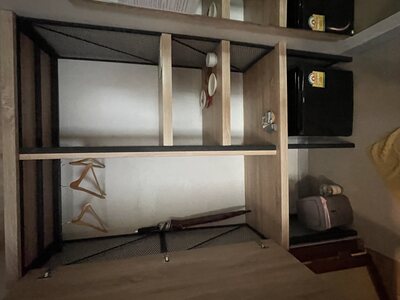

From the beach, we took a boat to a point called Karst Castle. On the way to the karst castle, thick stratified limestone of Ordovician age is beautifully visible. In some places, the formations are slowly forming anticlines, and in other places, the limestone is massive with no visible layers, which is very interesting. I discussed with Prof. Hisada that this is different from the blocky, narrowly distributed limestone of the Japanese Oristolith.
The canoe will take you to each observation point. The water is shallow, but be careful not to fall in.


The landing site can only be reached when the sea is calm and the tide is low. We were able to go down after meeting all of these conditions. Here, we checked the limestone rock under our feet.
Mr. F immediately found a trilobite. It was the only clearly recognizable trilobite this time. However, we could not find the compound eye, probably because of an impression of the ventral side.


Here is a snail.
However, what caught Prof. Hisada's attention here was the strange weathering pattern. He thinks this is BioTurviation. In other words, some organism must have dug a hole in the unconsolidated lime mud on the seafloor, which was then filled with the same material and left behind. In fact, the ODP borehole cores show tremendous bio-disturbance in the near-pristine areas. It seems that some of the bio-disturbance may be burrows or after searching for food.


There is a toilet and a bench here, where we ate our lunch.


Unfortunately, the information board was only in Thai. However, I could hear staffs of the boat acting as guides, explaining to the tourists in technical terms such as "Ordovician" mixed with Thai.
This is the fossil observation point on Fossil Island. There are 13 fossils in total on this wall, according to an explanation board.


Since we can not enter beyond the chain enclosure, the nearest of these shells was sprayed with water to see easier the internal structure. This is the interior of a Nortiloid. The septum is clearly visible.
This is another one near the foot.


Overall view of the outcrop.
This is a view of a beach on this island. We need to take care getting down from the boat to the beach using a canoe as a platform.


This was the last beach where we saw the natural monkeys. But as soon as they saw us, they disappeared into the forest. At that moment, I held up my iPhone to take a picture of the monkeys, but they ran away.
There are some strange limestone rocks on this beach. This one looks like Brachiopods.


Ms. W and I agreed that this is clearly a section of a Brachiopod.
Finally, this is a Paleozoic type ammonite I found, which I believe to be Goniatite.


It is difficult to see, but the central part is horizontal and falls off obliquely in the direction of travel, so I think I am looking at a part of the anticlinal structure. On the return trip, Prof. Hisada and me had another discussion about bio-disturbance, and he explained that the Ir seepage on the Cretaceous side of the K-T boundary must be the same. I was convinced.
Limestone coasts and islands. I realized that the world GeoPark is on a different scale rather than Japanese limestones.











